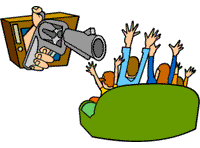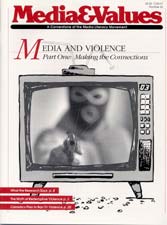Violence Formula: Analyzing TV, Video and Movies
|
This article originally appeared in Issue# 62
|
Violence is the foundation of many films, TV movies, and action series. In fact, violence is often synonymous with "action." Because screenwriters, directors and producers use violence often and in many ways, how do we begin to recognize the distinctions in media violence? How do we determine if shootout or fist fight is one too many? One way is to understand that there is a basic formula to the portrayal of violence in TV, movies and video. Here are the three basics of the formula, plus questions to help you recognize them:
1. Violence Drives the Storyline
Without the violence, there would be no story. A crime, a murder, a fist-fight are used to launch TV and movie plots. Violence is often the very pretext for the action that follows.
Take a look at your daily TV listings. Among films and TV movies, you're liable to find titles like Show of Force, Hell Squad, The Killers, The Naked and The Dead, The Plot to Murder Hitler, They Were Expendable, Masters of Menace, Missing in Action 2: The Beginning, and Conan The Destroyer. (These titles were collected by quickly leafing through a single issue of TV Guide.)
TV action series demonstrate a similar inclination for violence driving the story. An episode of Street Justice promises: "The brother of a suspected cop killer abducts Malloy in order to silence Beaudreaux, who is the only witness to the crime." On Star Trek: The Next Generation, "Geordi finds himself drawn romantically to a Starfleet lieutenant who is suspected of murder." On a re-run of Father Dowling Mysteries: "Someone takes a shot at Dowling and the culprit appears to be an angry ex-con Dowling helped send up the river on a murder rap."
TV and film plots begin with violence, and impending conflict continues to drive the story. The hero is never safe. Danger is always just around the corner. As the story unfolds, outbreaks of violence against people and property make sure that viewers stay in their seats.
2. Violence Has No Consequences
TV violence doesn't bleed. There are lots of shootouts and fist fights, but amazingly no one gets seriously hurt. TV rarely shows the consequences of violence. Guardians of law and order whether it's Maxwell Smart, Kojak, or the Miami Vice squad emerge from their conflicts with little more than a scrape. Occasionally, unlucky characters (but never the hero!) end up in a nice clean hospital bed.
In general, films depict bleeding, the immediate consequence of violence, more often than TV. In fact, horror movies celebrate gooey, graphic, gorey scenes. But even in these films, the real world consequences of violence — the physical handicaps, financial expense, and emotional cost — are never a part of the plot.
Perhaps the most chilling aspect of the media's portrayal of violence is that when people are killed, they simply disappear. No one mourns their death. Their lives are unimportant.
3. A World of Good and Bad
Media violence takes place in a world of good and bad. In most TV programs and movies, viewers' emotions have  to be enlisted very quickly. Starkly contrasting good and bad characters help accomplish this. Deeper, more realistic, more ambiguous characterizations make it hard for viewers to know who to root for. It also requires more screen time that takes away from on screen action.
to be enlisted very quickly. Starkly contrasting good and bad characters help accomplish this. Deeper, more realistic, more ambiguous characterizations make it hard for viewers to know who to root for. It also requires more screen time that takes away from on screen action.
As a result, TV and film criminals are reduced to caricatures. They are l00% bad. No one could care about them. They have no families. Many of them don't even have full names, only nick names. They deserve no sympathy and they get what they deserve.
Bad guys have to be really bad otherwise good guys wouldn't be justified in clobbering them. Good guys are peaceable. They are driven to violence only as a last resort in their struggle against these bad, bad people. Good guy violence is justified. To see how this self justifying formula works, ask a child why a particular character is getting beat up. Their answer is simple: "He's a bad guy."
How to Teach the Violence Formula to Others
Watch a popular action show, TV movie, or action film. Keep track of specific acts of violence such as shouting, hitting, shooting, car crashes and vandalism. (An interesting thing you'll notice if you skip through the channels looking for violent TV shows is that violence is a staple in some TV genres like crime and action shows, reality series, movies and cartoons and virtually non-existent in others). As you watch, apply the violence formula yourself by asking the following questions:
Violent Storylines
- What role does the violence play in the program?
- Would there be a story without the violent conflict?
- Is the violence used at intervals throughout the story to add excitement?
- Was this story developed because it is violent, or is it a valuable story of human relationships in which violence is a necessary and integral part?
Violent Consequences
- Are consequences of the violence shown? If so, what purpose does it serve the plot? How does it develop a character?
- Do you see people hurt or bleeding?
- Do those who die simply disappear?
- Are the economic and social consequences of violence clear? If not, how would the story change if it were shown?
Good Guys/Bad Guys
- How are the "good guys" and "bad guys" portrayed?
- Why do the "bad guys" use violence? Why do the "good guys" use violence?
- Do the "bad guys" have family or others who will care if they get hurt or killed?
- What kinds of violence do the "good guys" use? How do their acts of violence differ from those used by the "bad guys"?
Some Deeper Questions...
Now consider the impact of the media's portrayal of violence. Media violence has a different effect on children than it does on adults.
- CHILDREN model behavior they see in the media. If kids don't see the consequences of violence, it teaches them that violence doesn't cause serious harm. When heroes use violence it sends a message that violence is an appropriate way to respond to problems. If you were a child, what lessons about the world might you learn from the program you just watched?
- ADULTS see much more violence in the media than actually exists in real life. That's because producers believe that they have to include extraordinary violence in order to keep viewers interested. As a result, heavy TV viewers think that the world is more dangerous and violent than it actually is. This phenomenon is often called the "mean world" syndrome. How high is your mean world quotient? Do the shows you watch make you feel more fearful?



